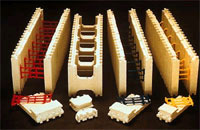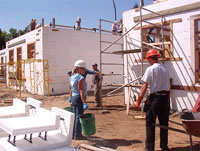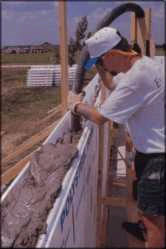Insulating concrete form systems (ICFs) have been successfully used by European and Canadian builders for decades, yet the systems did not make a mark in the United States until the 1990s. This builder-friendly wall system, which is a variation of poured-in-place concrete construction, has found its way into many new homes across every region and in every price range.
In conventional poured-in-place construction, a crew erects forms of plywood, steel, or aluminum that make a mold in the shape of the desired walls. After placing rebar to reinforce the wall, the crew pours concrete inside the cavity. Once the concrete hardens, the crew strips the forms to leave the reinforced concrete walls.
Unlike these removable forms, ICFs are designed to stay in place as a permanent part of the wall assembly. The formwork functions as the insulation and the concrete functions as the structure.
 A handful of these systems are manufactured from hybrid combinations of insulating materials, including wood fiber and cement, or plastic foam beads and cement. Far more commonly available are ICFs made with expanded or extruded polystyrene, containing up to 20 percent recycled materials. Expanded polystyrene is formed by expanding plastic beads in a mold and is similar to vending machine coffee cups. Extruded polystyrene is made by expanding plastic resin and extruding through a die and is similar to grocery store meat trays.
A handful of these systems are manufactured from hybrid combinations of insulating materials, including wood fiber and cement, or plastic foam beads and cement. Far more commonly available are ICFs made with expanded or extruded polystyrene, containing up to 20 percent recycled materials. Expanded polystyrene is formed by expanding plastic beads in a mold and is similar to vending machine coffee cups. Extruded polystyrene is made by expanding plastic resin and extruding through a die and is similar to grocery store meat trays.
Foam form units typically provide at least two inches of insulation on both faces of a concrete wall, which can commonly be four to 12 inches thick. The result is a solid assembly with strong thermal properties that holds down energy costs. The integral, permanent insulation allows builders to create super-efficient insulated walls—from an effective R-20 to R-40-in a fraction of the time required with wood or steel frame
The Basics
 There are two ways ICFs can arrive on the job: as blocks or planks. The block systems arrive at the site with plastic or metal ties and foam, pre-formed and ready to stack and interlock almost like children's building blocks. Plank systems come as separate panels or planks of foam that are assembled on site with individual ties. The block systems offer labor savings through faster assembly on the site while the plank systems offer savings through more compact shipping.
There are two ways ICFs can arrive on the job: as blocks or planks. The block systems arrive at the site with plastic or metal ties and foam, pre-formed and ready to stack and interlock almost like children's building blocks. Plank systems come as separate panels or planks of foam that are assembled on site with individual ties. The block systems offer labor savings through faster assembly on the site while the plank systems offer savings through more compact shipping.
Within these two basic ICF types, individual systems can vary in the profile of the wall they create. "Flat" systems yield a continuous thickness of concrete, like a conventionally poured wall. The wall produced by "grid" systems has a waffle pattern where the concrete is thicker at some points than others. "Post and beam" systems have just that—discrete horizontal and vertical columns of concrete that are completely encapsulated in foam insulation. Whatever their differences, all major ICF systems are engineer-designed, code-accepted and field-proven.
 While the formwork is stacked or assembled vertical and horizontal reinforcement is installed. Then contractors pump concrete into the cavity to create a solid structural wall with insulation on both sides. Once crews complete the wall, electricians cut channels for cables and wires into the forms. Plumbers can work in a similar way, placing cold and hot water lines in the insulation after the concrete is poured.
While the formwork is stacked or assembled vertical and horizontal reinforcement is installed. Then contractors pump concrete into the cavity to create a solid structural wall with insulation on both sides. Once crews complete the wall, electricians cut channels for cables and wires into the forms. Plumbers can work in a similar way, placing cold and hot water lines in the insulation after the concrete is poured.
The insulation provided by the forms gives builders the ability to successfully place concrete even during extremes of weather. Few weather conditions affect a pour because the form insulates the concrete, allowing it to cure while isolated from outside temperature or humidity. Because of ideal curing conditions created within the forms , the risk of serious cracks developing is diminished. The left-in-place forms provide a continuous insulation and sound barrier.
ICFs can be cut to any shape to allow for unique home designs or site conditions. Because ICFs provide a flat, continuous surface to work on, troweled finishes generally go onto ICFs with little advance preparation. In addition, the ends of the ties themselves are typically designed to accept fasteners to permit interior drywall to be installed directly over the forms. Similarly, this built-in furring permits mechanical attachment of exterior finishes like lath for stucco, furred and direct attached siding, or masonry veneer. There are even brick ledge forms to help further simplify brick installation.
Currently, ICFs are used to build walls for all types of buildings, and several manufacturers have additional forming components that will allow the construction of attached concrete floors and/or roofs. There are several brands of foam forming systems readily available in almost every region of the country.
For more information on insulating concrete forms,
click here or
here.